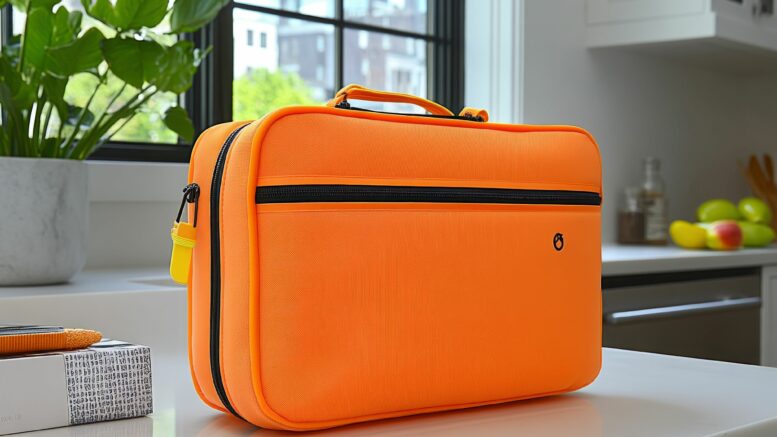When it comes to designing the perfect bag, fabric selection is more than just an aesthetic choice — it’s a decision that affects functionality, durability, comfort, and user satisfaction. While materials like nylon, canvas, and polyester dominate many mass-market products, neoprene is carving out a reputation as a quiet powerhouse in the world of specialty and performance-driven bags.
At our company, we’ve worked with neoprene across a wide range of industries — from healthcare to communications — and have seen firsthand where this material truly shines. If you’re considering neoprene for your next project, this guide will show you where it fits best and how we use it to solve real-world design challenges.
What Is Neoprene?
Neoprene is a synthetic rubber created through the polymerization of chloroprene. Known for its durability, flexibility, water resistance, and slight cushioning, it was originally developed in the 1930s and has since been used in everything from wetsuits to laptop sleeves. In the context of bags, neoprene brings a combination of form-fit comfort, protection, and resilience that few other materials can match.
Where Neoprene Shines: Our Experience in the Field
Neoprene isn’t a universal replacement for every bag application — but when it fits, it’s unbeatable. Over the years, we’ve seen it work exceptionally well in form-fitting, protective designs, particularly where soft contact with the body or equipment matters.
One of the best examples? A major project we completed for a wearable portable oxygen concentrator. The device had a rigid plastic shell, which patients carried around all day using a shoulder strap. After extended use, the hard casing caused discomfort. Our solution was a custom neoprene bag that snugly housed the concentrator while adding a soft-touch barrier between the device and the patient’s body. The result: better comfort, greater mobility, and improved satisfaction with the product.
Types of Bags Neoprene Is Ideal For
🔹 Medical Device Carrying Cases

Neoprene’s flexible structure and light cushioning make it perfect for medical gear that requires a secure fit — like diagnostic tools, small monitors, or wearable health devices. The material stretches just enough to keep the device snug without adding bulk.
🔹 Electronics Sleeves and Tech Protection
Neoprene is commonly used in laptop sleeves and electronic pouches for a reason: it offers lightweight padding that guards against everyday bumps and scratches, without the overkill of thick foam or hard shells.
🔹 Internal Pouches for Communication Equipment
In the communications industry, we’ve worked with clients who needed heavy-duty backpacks to carry large transmission equipment. While the backpacks themselves were made from rugged materials, they often required custom neoprene pouches inside to protect sensitive components like microphones, antennas, or interface modules. Neoprene offered the perfect combination of light structure, shock resistance, and easy access.
🔹 Tote Bags for Everyday Use
You’ll also see neoprene in fashion-forward tote bags. It’s soft, washable, and holds its shape well — making it ideal for go-everywhere bags that need to be lightweight, durable, and stylish.
🔹 Diaper Bag Inserts & Organizers
Because neoprene is soft, non-abrasive, and easy to clean, it’s a popular material for diaper bag sleeves, bottle holders, and organizational inserts where baby gear needs protection without fuss.
🔹 Rugged Hybrid Utility Bags
In some cases, we’ve combined foam inserts and neoprene layers to create bags that carry gear in tough environments while still offering a comfortable or flexible interface. Think tools, field kits, and mobile diagnostics.
Why Neoprene? Pros and Considerations
✅ Advantages:
- Water-Resistant: Naturally repels moisture.
- Light Padding: Protects gear without bulk.
- Soft Touch: Comfortable to wear or handle.
- Flexible & Stretchy: Adapts to varied shapes and contents.
- Durable: Resists tears, abrasion, and UV damage.
⚠️ Considerations:
- Thicker Material: Neoprene adds volume compared to standard textiles.
- Not Breathable: May trap heat or moisture if not ventilated properly.
- Lacks Structure: On its own, neoprene isn’t rigid — but can be layered or reinforced to address that.
Our Approach to Manufacturing with Neoprene
Neoprene requires specific production know-how. We use specialized cutting and sewing machines to handle its thickness and elasticity, ensuring clean lines and consistent seams. Our team is experienced in prototyping fit-sensitive designs, such as molded sleeves and wraparound gear bags.
Whether we’re developing internal pouches for tech protection or medical-grade shoulder bags, our focus is always on pairing neoprene’s strengths with the needs of the end user.
A Note on Sustainability
Neoprene is traditionally made from petrochemical derivatives, which raises environmental concerns. However, greener alternatives like limestone-based neoprene, Yulex (natural rubber), and recycled neoprene blends are becoming more available.
We support customers seeking lower-impact solutions by:
- Offering sourcing options for eco-conscious neoprene
- Maximizing material yield through precise cutting
- Recycling offcuts and neoprene waste where feasible
When Neoprene Is the Right Choice
Neoprene is a smart solution when you need:
- A soft-touch alternative to hard plastic
- A snug, protective fit for delicate gear
- Lightweight water resistance
- A comfortable bag for close-to-body wear
If your product or user experience demands comfort, flexibility, and lightweight protection — neoprene may be the answer.
Learn More About What We Do
We’ve built everything from custom neoprene pouches to fully tailored medical bags. If you’re exploring neoprene for your next bag project, we’d love to help.

